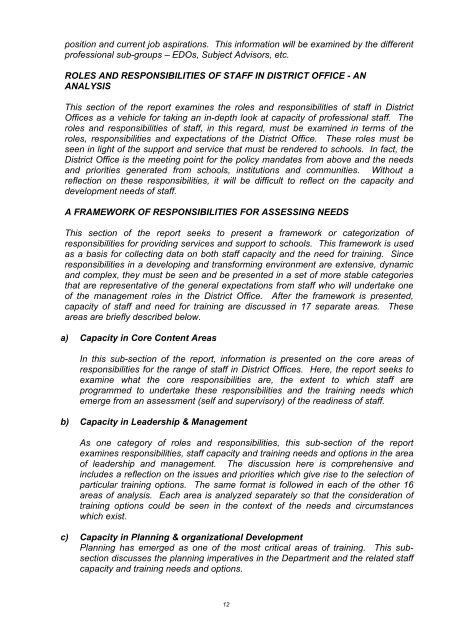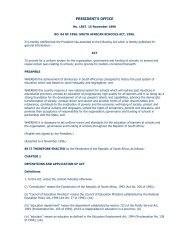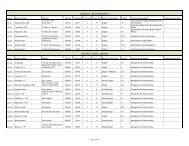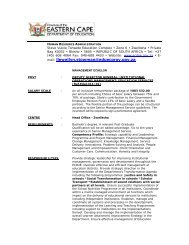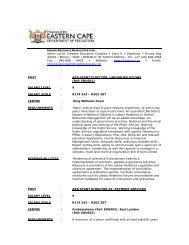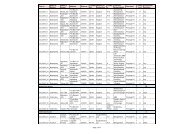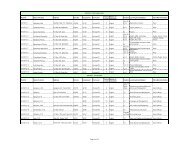Assessment of Needs and Capacity of District Office Professional Staff
Assessment of Needs and Capacity of District Office Professional Staff
Assessment of Needs and Capacity of District Office Professional Staff
Create successful ePaper yourself
Turn your PDF publications into a flip-book with our unique Google optimized e-Paper software.
position <strong>and</strong> current job aspirations. This information will be examined by the different<br />
pr<strong>of</strong>essional sub-groups – EDOs, Subject Advisors, etc.<br />
ROLES AND RESPONSIBILITIES OF STAFF IN DISTRICT OFFICE - AN<br />
ANALYSIS<br />
This section <strong>of</strong> the report examines the roles <strong>and</strong> responsibilities <strong>of</strong> staff in <strong>District</strong><br />
<strong>Office</strong>s as a vehicle for taking an in-depth look at capacity <strong>of</strong> pr<strong>of</strong>essional staff. The<br />
roles <strong>and</strong> responsibilities <strong>of</strong> staff, in this regard, must be examined in terms <strong>of</strong> the<br />
roles, responsibilities <strong>and</strong> expectations <strong>of</strong> the <strong>District</strong> <strong>Office</strong>. These roles must be<br />
seen in light <strong>of</strong> the support <strong>and</strong> service that must be rendered to schools. In fact, the<br />
<strong>District</strong> <strong>Office</strong> is the meeting point for the policy m<strong>and</strong>ates from above <strong>and</strong> the needs<br />
<strong>and</strong> priorities generated from schools, institutions <strong>and</strong> communities. Without a<br />
reflection on these responsibilities, it will be difficult to reflect on the capacity <strong>and</strong><br />
development needs <strong>of</strong> staff.<br />
A FRAMEWORK OF RESPONSIBILITIES FOR ASSESSING NEEDS<br />
This section <strong>of</strong> the report seeks to present a framework or categorization <strong>of</strong><br />
responsibilities for providing services <strong>and</strong> support to schools. This framework is used<br />
as a basis for collecting data on both staff capacity <strong>and</strong> the need for training. Since<br />
responsibilities in a developing <strong>and</strong> transforming environment are extensive, dynamic<br />
<strong>and</strong> complex, they must be seen <strong>and</strong> be presented in a set <strong>of</strong> more stable categories<br />
that are representative <strong>of</strong> the general expectations from staff who will undertake one<br />
<strong>of</strong> the management roles in the <strong>District</strong> <strong>Office</strong>. After the framework is presented,<br />
capacity <strong>of</strong> staff <strong>and</strong> need for training are discussed in 17 separate areas. These<br />
areas are briefly described below.<br />
a) <strong>Capacity</strong> in Core Content Areas<br />
In this sub-section <strong>of</strong> the report, information is presented on the core areas <strong>of</strong><br />
responsibilities for the range <strong>of</strong> staff in <strong>District</strong> <strong>Office</strong>s. Here, the report seeks to<br />
examine what the core responsibilities are, the extent to which staff are<br />
programmed to undertake these responsibilities <strong>and</strong> the training needs which<br />
emerge from an assessment (self <strong>and</strong> supervisory) <strong>of</strong> the readiness <strong>of</strong> staff.<br />
b) <strong>Capacity</strong> in Leadership & Management<br />
As one category <strong>of</strong> roles <strong>and</strong> responsibilities, this sub-section <strong>of</strong> the report<br />
examines responsibilities, staff capacity <strong>and</strong> training needs <strong>and</strong> options in the area<br />
<strong>of</strong> leadership <strong>and</strong> management. The discussion here is comprehensive <strong>and</strong><br />
includes a reflection on the issues <strong>and</strong> priorities which give rise to the selection <strong>of</strong><br />
particular training options. The same format is followed in each <strong>of</strong> the other 16<br />
areas <strong>of</strong> analysis. Each area is analyzed separately so that the consideration <strong>of</strong><br />
training options could be seen in the context <strong>of</strong> the needs <strong>and</strong> circumstances<br />
which exist.<br />
c) <strong>Capacity</strong> in Planning & organizational Development<br />
Planning has emerged as one <strong>of</strong> the most critical areas <strong>of</strong> training. This subsection<br />
discusses the planning imperatives in the Department <strong>and</strong> the related staff<br />
capacity <strong>and</strong> training needs <strong>and</strong> options.<br />
12


